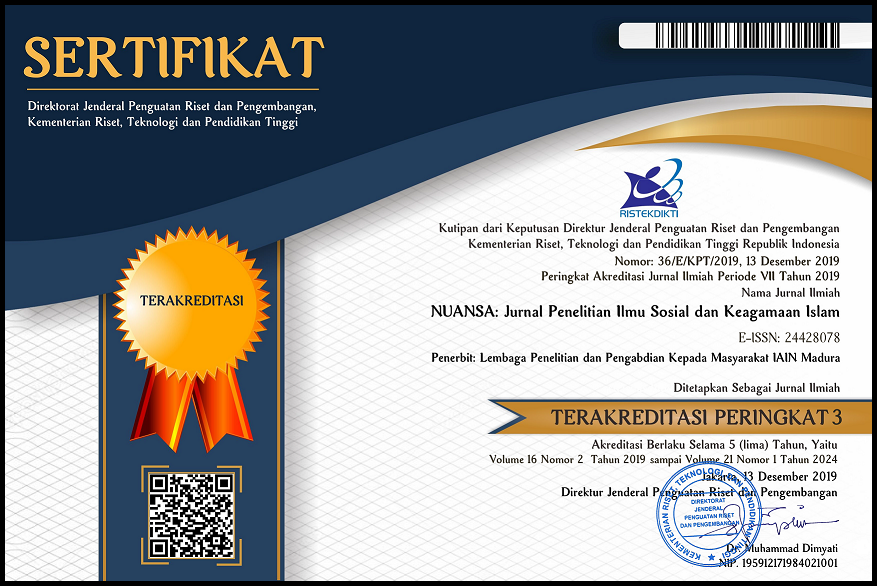PENGARUH FAKTOR FUNDAMENTAL TERHADAP HARGA SAHAM PERUSAHAAN YANG TERDAFTAR DI LQ 45 BURSA EFEK INDONESIA
 Abstract views: 236
,
Abstract views: 236
,
 PDF downloads: 239
PDF downloads: 239
Abstract
Downloads
References
Abdul Halim. 2007. Manajemen Keuangan Bisnis. Bogor: Ghalia Indonesia.
Agus Widarjono. 2015. Analisis Multivariate Terapan. Yogyakarta: UPP STIM YKPN.
Bodie, Zvi, Kane, Alex and Marcus, Alan J. 2005. Investment. Mc Graw, Hill International Edition.
Dahlan Siamat. 1999. Manajemen Lembaga Keuangan. Jakarta: Lembaga Penerbit Fakultas Ekonomi Universitas Indonesia.
Damodar N Gujarati. 2006. Dasar-dasar Ekonometrika. Jakarta: Erlangga.
Edwin J. Elton dan Martin J. Grubber. 1987. Modern Portofolio Theory and Investment Analysis. New York: John Wiley & Son.
Eugene F. Brigham, Joel F. Houston. Essentials Of Financial Managemen. Jakarta: Salemba 4.
Humphrey Wangke. 2014, Peluang Indonesia Dalam Masyarakat Ekonomi ASEAN 2015. Jurnal: Info Singkat, vol VI No.10/II/P3DI/Mei/2014, ISSN 2088-2351.
Husaini Usman dan R. Purnomo Setiady Akbar. 2003. Pengantar Statistika. Jakarta: PT Bumi Aksara.
Imam Ghozali. 2009. Ekonometrika : Teori, Konsep dan Aplikasi dengan SPSS 17. Semarang: BP UNDIP.
Inung Adi Nugroho. 2009. AnalisisPengaruh Informasi Fundamental Terhadap Return Saham: Studi Komparatif pada Subsektor Industri Otomotif Terhadap Subsektor Industri Textil Sepanjang Periode Tahun 2003 sampai dengan Tahun 2007 di Bursa Efek Indonesia, Tesis, Universitas Diponegoro, Semarang.
Irham Fahmi. 2014. Manajemen Keuangan dan Pasar Modal. Jakarta: Mitra Media Wacana.
J.P Sitanggang. 2014. Manajemen Keuangan Perusahaan. Jakarta: Mitra Wacana Media.
Jamalul Abidin. 2009. Analisis Faktor Fundamental Keuangan dan Resiko Sistematik Terhadap Harga Saham Perusahaan Consumer Goods Yang Terdaftar di Bursa Efek Indonesia. Tesis, Universitas Sumatera Utara, Medan.
Jogiyanto. 2011. Konsep dan Aplikasi SEM. Yogyakarta: UPP STIM YKPN.
Jun Yamamoto dan Atsumu Ogawa. First Step in Fundamental Analysis. Jakarta: Kompas Gramedia.
Jurnal Ekonomi. Vol 6 Edisi 2 Januari-April 2013.
Keputusan Menteri Keuangan RI No 1548/KMK/90, tentang Peraturan Pasar Modal.
Lukman Syamsuddin. 2009. Manajemen Keuangan Perusahaan. Jakarta: PT RajaGrafindo Persada.
Mamduh M. Hanafi dan Abdul Halim. Analisis Laporan Keuangan. Yogyakarta: UPP STIM YKPN.
Mudrajad Kuncoro. 2015. Indikator Ekonomi. Yogyakarta: UPP STIM YKPN.
Mudrajad Kuncoro. Metode Kuantitatif. Yogyakarta: UPP STIM YKPN.
Muhammad. 2008. Metodologi Penelitian Ekonomi Islam: Pendekatan Kuantitatif. Jakarta : PT Raja Grafindo Persada.
Nachrowi D Nachrowi dan Hardius Usman. 2006. Ekonometrika. Jakarta: LPFEUI.
R. Agus Sartono. 2010. Manajemen Keuangan: Teori dan Aplikasi. Yogyakarta: BPFE Yogyakarta.
Suad Husnan dan Pudjiastuti. 1994. Dasar Manajemen Keuangan. Yogyakarta : Unit Penerbit dan Percetakan AMP YKPN.
Suad Husnan. 2015. Dasar-dasar Teori Portofolio & Analisis Sekuritas. Yogyakarta: UPP STIM YKPN.
Suad Husnan. 1998. Manajemen Keuangan; Teori dan Penerapan. Yogyakarta: BPFE.
Sugiyono. 1998. Metode Penelitian Administrasi. Bandung: Alfabeta.
Sugiyono. 2011. Metode Penelitian Kuantitatif dan Kualitatif dan R&D. Bandung: Alfabeta.
Sunariyah. 2011. Pengantar Pengetahuan Pasar Modal. Yogyakarta: UPP STIM YKPN.
Supardi, U.S. 2013. Aplikasi Statistika Dalam Penelitian: Konsep Statistika Yang Lebih Kompreherensif. Jakarta: Change Publisher.
Susan Grace Veranita Nainggolan. 2008. Pengaruh Variabel Fundamental Terhadap Harga Saham Perusahaan Manufaktur yang Terdaftar di Bursa Efek Indonesia. Tesis, UNDIP, Universitas Sumatera Utara, Medan.
Tangkilisan, Hessel Nogi S. 2003. Memahami Kinerja Keuangan Perusahaan. Yogyakarta: Balairung&Co.
William F Sharpe, Gordon J Alexander, Jeffery V Bailey. 1995. Investasi. New Jersey: Prentice Hall, Inc.
Zalmi Zubir. 2011. Manajemen Portofolio: Penerapannya Dalam Investasi Saham. Jakarta: Salemba Empat.
The journal operates an Open Access policy under a Creative Commons Attribution-NonCommercial 4.0 International License (CC-BY-NC) 
Authors who publish with this journal agree to the following terms:
- Authors retain copyright and grant the journal right of first publication with the work simultaneously licensed under a Creative Commons Attribution License that allows others to share the work with an acknowledgement of the work's authorship and initial publication in this journal.
- Authors are able to enter into separate, additional contractual arrangements for the non-exclusive distribution of the journal's published version of the work (e.g., post it to an institutional repository or publish it in a book), with an acknowledgement of its initial publication in this journal.
- Authors are permitted and encouraged to post their work online (e.g., in institutional repositories or on their website) prior to and during the submission process, as it can lead to productive exchanges, as well as earlier and greater citation of published work.






















